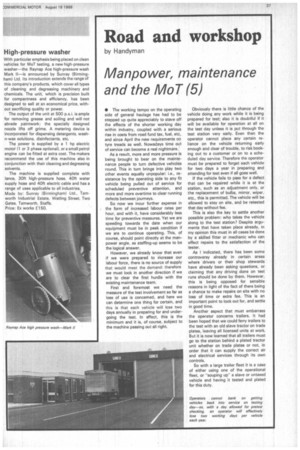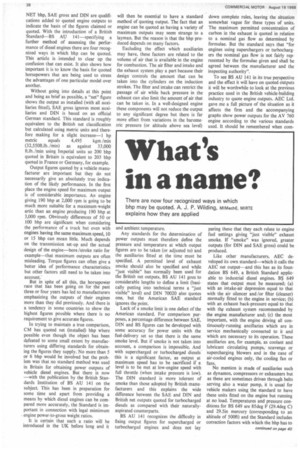Manpower, maintenance
Page 39

Page 40

If you've noticed an error in this article please click here to report it so we can fix it.
and the MoT (5)
• The working tempo on the operating side of general haulage has had to be stepped up quite appreciably to stave off the effects of the shorter working day within industry, coupled with a serious rise in costs from road fund tax, fuel, etc, and since April the new requirements on tyre treads as well. Nowadays time out of service can become a real nightmare.
As a result, more and more pressure is being brought to bear on the maintenance people to turn defective vehicles round. This in turn brings into play two other events equally unpopular: i.e., resistance by the operating side to any fit vehicle being pulled out of service for scheduled preventive attention, and more and more overtime to clear running defects between journeys.
So now we incur further expense in the form of increased labour rates per hour, and with it, have considerably less time for preventive measures. Yet we are speeding towards the date when our equipment must be in peak condition if we are to continue operating. This, of course, should point directly at the manpower angle, as staffing-up seems to be the logical answer.
However, we already know that even if we were prepared to increase our labour force, there is no source of supply that would meet the demand: therefore we must look in another direction if we are to clear the first hurdle with the existing maintenance team.
First and foremost we need the measure of the test involvement so far as loss of use is concerned, and here we can determine one thing for certain, and this is that each vehicle will lose two days annually in preparing for and undergoing the test. In effect, this is the minimum and it is, of course, subject to the machine passing out all right. Obviously there is little chance of the vehicle doing any work while it is being prepared for test; also it is doubtful if it will be available for operation at all on the test day unless it is put through the test station very early. Even then the operator cannot place any certain reliance on the vehicle returning early enough and clear of trouble, to risk booking out to a customer or on to a scheduled day service. Therefore the operator must be prepared to forget each vehicle for two days a year in preparing and attending for test even if all goes well.
If the vehicle fails to pass for a defect that can be repaired while it is at the station, such as an adjustment only, or the replacement of bulbs, mirror, wiper, etc., this is permitted. The vehicle will be allowed to stay on site, and be retested that day without fee.
This is also the key to settle another possible problem: who takes the vehicle along to the test station? Despite arguments that have taken place already, in my opinion this must in all cases be done by a skilled fitter or mechanic who can effect repairs to the satisfaction of the tester.
As I indicated, there has been some controversy already in certain areas where drivers or their shop stewards have already been asking questions, or claiming that any driving done on test runs should be done by them. However, this is being opposed for sensible reasons in light of the fact of there being a chance to make repairs on site with no loss of time or extra fee. This is an important point to look out for, and settle in good time.
Another aspect that must embarrass the operator concerns trailers. It had been hoped that we could ferry trailers to the test with an old slave tractor on trade plates, leaving all licensed units at work. But it is now learned that all trailers must go to the station behind a plated tractor unit whether on trade plates or not, in order that it can supply the correct air and electrical services through its own controls.
So with a large trailer fleet it is a case of either using one of the operational fleet, or -souping up" a slave or untaxed vehicle and having it tested and plated for this duty.
NET bhp, SAE gross and DIN are qualifications added tO quoted engine outputs to indicate the basis of the figures claimed or quoted. With the introduction of a British Standard—BS AU 141—specifying a further method of assessing the performance of diesel engines there are four recognized ways in which bhp can be quoted. This article is Intended to clear up the confusion that can exist. It also shows how important it is to know the basis for quoted horsepowers that are being used to stress the advantages of one particular model over another.
Without going into details at this point and being as brief as possible, a "net" figure shows the output as installed (with all auxiliaries fitted), SAE gross ignores most auxiliaries and DIN is based on an official German standard. This standard is roughly equivalent to the British net classification but calculated using metric units and therefore making for a slight increase-1 hp metric equals 4,495 kgm /min (32,550ft.lb. /min) as against 33,000 /min using Imperial units so 200 bhp quoted in Britain is equivalent to 203 bhp quoted in France or Germany, for example.
Output figures quoted by a vehicle manufacturer are important but they do not necessarily give an absolutely true indication of the likely performance. In the first place the engine speed for maximum output is of considerable importance. An engine giving 190 bhp at 2,000 rpm is going to be much more suitable for a maximum-weight artic than an engine producing 190 bhp at 3,000 rpm. Obviously differences of 50 or 100 bhp are significant when considering the performance of a truck but even with engines having the same maximum speed, 10 or 15 bhp can mean little. Much depends on the transmission set-up and the actual design of the engine—bore/stroke ratio for example—that maximum outputs are often misleading. Torque figures can often give a better idea of performance characteristics but other factors still need to be taken into account: But in spite of all this, the horsepower race that has been going on for the past three or four years has led to manufacturers emphasizing the outputs of their engines more than they did previously. And there is a tendency in some countries to show the highest figures possible where there is no requirement to give accurate figures.
In trying to maintain a true comparison, CM has quoted net (installed) bhp where possible even though the object has been defeated to some small extent by manufacturers using differing standards for obtaining the figures they supply. No more than 5 or 6 bhp would be involved but the problem was that no standard method was used in Britain for obtaining power outputs of vehicle diesel engines. But there is now —with the publication by the British Standards Institution of BS AU 141 on the subject. This has been in preparation for some time and apart from providing a means by which diesel engines can be compared more accurately, the Standard is important in connection with legal mimimum engine power-to-gross weight ratios.
It is certain that such a ratio will be introduced in the UK before long and it will then be essential to have a standard method of quoting output. The fact that an engine can be quoted as having a variety of maximum outputs may seem strange to a layman. But the reason is that the bhp produced depends on many factors.
Excluding the effect which auxiliaries may have, these factors are related to the volume of air that is available in the engine for combustion. The air filter and intake and the exhaust system play a part because their design controls the amount that can be taken into the cylinders on the induction strokes. The filter and intake can restrict the passage of air while back pressure in the exhaust can also limit the amount of air that can be taken in. In a well-designed engine these components will not reduce the output to any significant degree but there is far more effect from variations in the barometric pressure (or altitude above sea level)
down complete rules, leaving the situation somewhat vague for these types of units. The maximum permitted concentration of carbon in the exhaust is quoted in relation to a nominal gas flow as determined by formulae. But the standard says that "for engines using superchargers or turbochargers the nominal gas flow is not fairly represented by the formulae given and shall be agreed between the manufacturer and the inspecting authority".
To see BS AU 141 in its true perspective and the effect it will have on quoted oUtputs it will be worthwhile to look at the previous practice used in the British vehicle-building industry to quote engine outputs. AEC Ltd. gave me a full picture of the situation as it affects the firm and the accompanying graphs show power outputs for the AV 760 engine according to the various standards used. It should be remembered when corn




































































































